![]()
The Charlotte News
Wednesday, January 27, 1943
THREE EDITORIALS
![]()
![]()
Site Ed. Note: The front page stresses only two stories: the Casablanca Conference, and the cornering by the Soviets of the remaining 12,000 Nazi troops inside Stalingrad, half in the northern sector and the other half in the central sector of the city, each separated, each starving with an estimated two to three days left before mass death would become their fate. The Russians claimed the merciless numbers of 40,000 killed and 28,000 taken prisoner just in the previous 17 days since January 10.
As Kaiser Wilhelm had warned on the example of Napoleon: Never invade Russia.
Any more than you would wish likewise the results for invasion of the United States or Great Britain.
The news from the Casablanca Conference remained vague, that Roosevelt, Churchill, De Gaulle and Giraud had met, pledged to prosecute the war vigorously in the ensuing year, would accept nothing short of unconditional surrender of each of the Axis nations, affirmed a united front by each of the Allies, and indicated that they had communicated with both Chiang Kai-Shek and Stalin regularly during the ten-day conference to keep them informed of developments.
Stalin had been invited; it was not clear as to Chiang. Given the fact that the Chinese military diplomatic entourage had left Washington three weeks earlier for want of anything to do, after their general exclusion from war councils, receiving only periodic briefings from the State Department, but no consultation on policy decisions or how to fight the Japanese against whom they had four and a half years more experience at fighting than did America, it was likely the case that Chiang did not wish to attend the conference to save face. Or, did not wish to create the false impression to the people of China that the Chinese view was completely amalgamated into the war, despite close cooperation between Chiang and the Allied air force in China under the command of Claire Chennault and the infantry under the command of Joseph Stilwell, both of whose commands Chiang had personally sought and approved.
Regardless, the conference pledged continued and increased aid to both China and Russia, a sine qua non for their winning the wars in each theater.
De Gaulle and Giraud met separately over the course of two days to iron out their differences and issued a joint statement tersely indicating their agreed commitment to defeat the Axis, liberate France, and restore the free republic, that these goals could only be achieved by the unity of all Frenchmen during the war.
The statement left unresolved the command structure--and to many observers at the time appeared altogether too spare to engender optimism of a healed rift between the two leaders of the French.
Speculation ran that a new Allied drive would commence on the Continent as soon as North Africa was secure. As yet, however, there was no indication of such a plan issued from the conference, even if the President's message the day before in Belfast, stressing that the new plan was offense, not defense, to be characterized by unrelenting attack, gave such a plain signal, and, indeed, one which would be manifested by action during the summer months as the invasion of Sicily began shortly after North Africa was secured in May.
The editorial page begins with Burke Davis providing high praise for the conference, suggesting that its results appeared favorable and sound, criticism of its exclusion of Stalin and Chiang Kai-Shek and not enough concrete resolution of the division between De Gaulle and Giraud notwithstanding.
"Rights for the States" finds the ideal expressed by Governor Broughton of North Carolina to the other governors at a governorsí conference in Baltimore, that the states should exert more independence from Washington and push for smaller Federal control, to be unlikely of achievement, especially under the New Deal, as long as it remained in power--as it would for yet another decade, even if morphed into the "Fair Deal" under President Truman.
The old cry of "states' rights" would become all too synonymous with racism and segregation in the 1950's and 1960ís ever to be viewed very objectively as having any other meaning by a generation growing of age, cringing at its very utterance.
In 1943, however, Governor Broughton appeared to stress less entanglement in Federal bureaucratic red tape, a common complaint against the New Deal even by its ardent supporters, and to strive for more state initiative to accomplish the goals of the New Deal without the Federal encumbrances which stultified initiative. While Governor Broughton was no progressive on racial integration, as no governor, in truth, Southern or otherwise, of his time was by modern standards, embracing social and economic integration as a rallying cry for change, he was neither a strict segregationist of the reactionary stripe of the Bilbos and Bleases of his time, as the term came to embrace the Barnetts, Pattersons, Wallaces, Faubuses, Maddoxes, and many others representative of the obscurantist view antithetical to the progress sought in the later civil rights era; nor was the issue of integration and civil rights by 1943 one with any megaphone aloud the land, with all energies of the society and its governmental resources consumed and overburdened by war, its outcome, and the future world after its duration. Thus, it is not likely that the governor intended any racial allusion to his invitation, as it might have rung in 1938 when Federal anti-lynching legislation, considered a "force bill" to the South, was being considered by the Congress; now, it would have been pointless, a cry of the wolf in the wilderness.
Samuel Grafton addresses the people of Germany and asks them to consider why Hitler and his press organs were now, as never before, proclaiming the specter of defeat in Stalingrad and the Caucasus, why funeral hymns were being played on German radio preceding these proclamations, why fear was being used on the German people in the same manner it had been before on Poland, England, France, and Czechoslovakia. The answer he finds to be simple: that Hitler was out of gas in reaching any foreign people with his message of terror, that he had at last turned that message to Germany, itself, and for the same reason as his message had always been addressed in like terms, to perpetuate his and his Party's power over the people, to avoid being overrun by revolt, internally and from without the government.
Finally, a letter writer, frequent contributor to the "Platform of the People", addresses astutely the issue of the French leadership under General Giraud, questioning how it was, as we have done, that General Giraud managed to escape from the hands of the Nazis in such a bizarre manner as he described--indeed, one precisely as that set forth in the 1937 French film, La Grande Illusion, even set in a similar castle on a high cliff as that from which Giraud said he escaped, Konigstein Castle outside Dresden. How did the Nazis let slip by their prying eyes threads sent to him by his wife in sufficient quantity that he was able in time to weave a rope from them? The letter writer wants to know.
The answer is that he probably did not escape that way and simply lifted the scenario from the film, knowing that the Nazis would not understand the scene for their own censorship since 1933. But that does not necessarily mean, even if so, that he was a double agent, that the Nazis let him go for a sinister purpose, to use him as a supposedly cooperative Allied sympathizer while he fed information to the Nazi High Command. His ruse, if it was that, could have been to protect a guard or higher authority in the prison framework who let him go because they were also French or of French heritage and did not accept the Nazi credo, though forced to cooperate and wear the uniform of the Reich for the sake of their own families.
Or, it could have been more or less as Giraud explained it.
But since Giraud had served under Petain, the national hero, in World War I, and since Petain had become a collaborator with the Nazis in 1940, it is conceivable that it was Petain who effected his release. Still, such a scenario does not necessarily imply thereby that Giraud was a spy, a secret collaborator, simply by becoming the recipient of a political favor from an old military friend who happened also to be a collaborator.
We shall see if anything surfaces concretely through time which either lends credence to the notion of Giraud wearing a mask of deceit or serves to spite it.
Chapter 21 of They Were Expendable finds Lieutenant Kelly and the other three unwounded men of his crew finding native help to move the wounded to a launch on the other side of Kawit Island, for transport to a hospital on Cebu. Sheppard, a machinist's mate, was placed in charge of the launch.
After the wounded had departed, Ensign Richardson, sent ahead before dawn to summon help for the critically injured cook and port gunner, Reynolds, arrived with a doctor aboard a banca--a native outrigger fishing canoe with sails. Kelly loaded the papers and salvaged equipment from PT-34 onto the banca and headed to Cebu.
Halfway across to the island, the three Japanese planes returned overhead but were only looking for their downed fourth pilot this time--probably to machine-gun him to death if spotted, based on other reports during the early part of the Pacific war as to how the Japanese treated their own. There was no attempt at rescue, even at sea. They typically killed the pilot to prevent his capture and revelation of information. Apparently, the pilot and plane were no more.
Once in Cebu, Kelly inquired of the whereabouts of Lieutenant Bulkeley and his PT-41 crew. There was no word.
The Army colonel to whom he reported on the mission's results suggested that Kelly give his report to the general. Moreover, Kelly wanted to know what had happened to the promised air umbrella, failing which, his crew had been shot to pieces, one man dead, another dying, the rest, save himself and three others, wounded. The general might have the answer; the colonel didnít.
The colonel and Kelly went to see the general while he was in conference at the American Club. They waited for several minutes, but despite the general apparently observing their patient standing aside, he gave no indication that they should join his table.
Kelly got mad at what seemed to him, in his exhausted condition, an inexcusable snub by a thoughtless brasshat, turned down the colonel's invitation to drink, had a Coca-Cola to cool down, and then left the bar in a huff.
Still possessing vague illusions that he might obtain repairs to PT-34 from "Dad" Cleland, he ordered the boat guarded and thought about refloating it at high tide around 4:00 to be towed to dry dock.
But before the afternoon was over, he would receive news from Ensign Richardson that Reynolds had died at the hospital and that his and Harris's funerals were to be held at 4:00. So that he could attend the burials, he abandoned the idea of saving the boat. Richardson promised to meet him at the American Club and take him to the services, but didnít show. Kelly again got mad and frustrated. He later discovered that the funerals had been postponed until 10:00 a.m. the next morning.
At the club, Kelly struck up a friendly conversation with the American owner who lent him a sympathetic ear about his ordeal in battle during the previous 24 hours, strafed with death, splashed with blood, pressed to the limits of existence by unremitting gunfire, after a successful mission with Bulkeley to destroy the Kuma-class cruiser near Negros Island.
The owner, seeing that Kelly was upset and exhausted, invited him to his home for supper and a place to sack out for the night.
Right after chow, Kelly hit the bed. Winding down from the rushing events of the previous night and day, he turned on the radio for a bit only to hear, instead of music out of his favorite shortwave broadcaster in San Francisco, the crushing news that Bataan had been surrendered to the Japanese. His thoughts wandered wildly to Peggy, probably moved to Corregidor to await her turn with the others to become expendable. He wanted to thank her for the two codeine tablets she had provided him on their last meeting, which he had given to Reynolds, bleeding, supine on PT-34's deck before the dawn raid, affording him temporary relief for his last smoke even with a bullet hole through his throat.
The skipper, after his last mission of this Battle for the Philippines, realized now that he and his crew were expended, every bit as much as those on Bataan and Corregidor. He wished that he could commiserate with them, explain that his plight was little if any better. He wished he could be there.
At 4:25 a.m., he was rocked awake by a blast from down below the house, then another. The owner told him that the Army was blowing the works at Cebu to avoid capture of the petroleum facilities by the Japanese who had already landed at three points on the beach.
Kelly hurriedly dressed and made his way down to Cebu City, trying to locate his three crew members, wanting to help the Army if he could. They told him that there was nothing to do, to seek the inland Camp X which would be the fort until reinforcements and air cover arrived, or to join the evacuation.
While in the confused hurly-burly of the town, he heard from some Navy personnel that the Japanese planes had come back newly loaded with bombs later the previous afternoon and had finished off PT-34 with the coup de gras--the head shot.
The tough PT-34 of Squadron 3 was no more.
Lieutenant Brantingham had been forced to burn his PT-35 boat in dry dock at "Dad" Cleland's to avoid having it captured by the enemy. They also informed him that Ensign Richardson had gathered up the remaining men from Kelly's crew and gone to Mactan Island to attempt from there to effect escape to Leyte.
Kelly was in a quandary as to what to do next. He returned to the American Club owner's house and watched the Japanese invade the island from the second story window.
Below, we provide some photographs of PT-boats during and after construction at Higgins Industries in New Orleans, a company which acquired during 1942 a Navy contract to build the boats. Other boats, including PT-109, skippered beginning in April, 1943 by John Kennedy, were built by Elco in Bayonne, N.J. The pictures show the plywood hull construction, not plywood in the post-war sense of laminated sheets, though such sheets were utilized to form the motor mounts and the decking, but rather strips of mahogany laminated together to form boards which could be shaped to form the hull ribs as they were laminated by stretching the thin strips comprising each lamination over molds while being glued together. The siding of the boat, attached to the hull skeleton, typically was comprised of white oak boards steam bent around forms to match the curvature of the hull. The first layer was topped by water-proof glue and airplane cloth, forming a watertight seal, followed then by another layer of boards in a cross-grain pattern to provide maximum strength. The top layer of boards may be seen in their diagonal pattern, prior to the marine coating to provide a waterproof skin, in the view astern of the boats in the first picture.
For optimum guard against permeability, the boat needed to sit in water for a day or so for the wooden hull to soak up enough moisture to expand the joints of the boards to form watertight seals, a method used in wooden ship building through the ages. Inevitably, no wooden shiplap boat is watertight until this expansion takes place.
They were expandable.
The bottom picture shows the finished product, replete with its forward and aft lateral torpedo tubes. In aiming these torpedoes, without navigational equipment, the torpedoman had to become an expert at guiding the skipper to proper range and direction of the boat before each tube was fired. They were immovable and so the boat had to steer a path at an angle off 90 degrees to the target, either right or left, depending on which side was to be fired. Obviously, broadside approaches were preferred to afford a wider target, as aiming ultimately was pure trial and error guesswork and in the thick of battle with gunfire inevitably spraying the boat and its crew as it tried to deliver its load, a dauntless and tedious operation, however unerring it had to be for only four chances at a hit being available per fully loaded boat. The turn of the boat to fire the first two torpedoes, however, also meant that the boat was into its escape arc well before the torpedoes or their wakes would be spotted by the enemy target.
The reasons for the choice of plywood over steel construction were several: the absence of plentiful supplies of steel and its base iron ore during the war; the absence of proper facilities in the Philippines and then subsequently in the remote Solomons for repair of steel ships; and the prevalent use of wooden boats at the time as small craft, motor boats and yachts, in an age preceding fiberglass construction and at the inception of use of plastics, enabling speed and maneuverability, hit and run operations on large ships, at the expense of security to the crew--truly a fatalistic endeavor from beginning to end.
We'll take five, Higgins, and deliver them to General Tojo.
Whatever happened to General Tojo? Neither Kelly nor Bulkeley ever informs us. Maybe he went along with General MacArthur to Australia and eventually was launched into outta space.
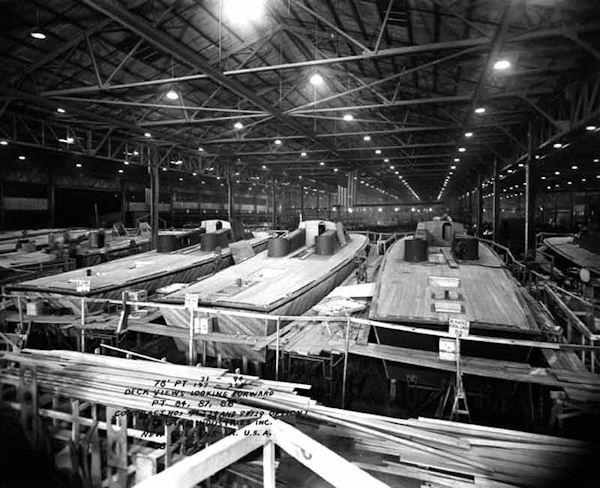
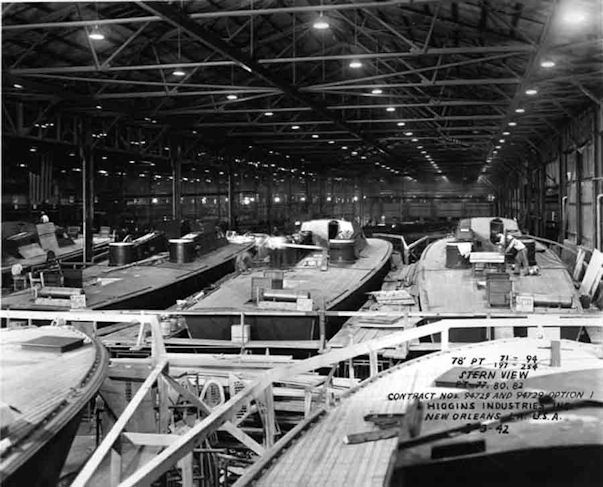
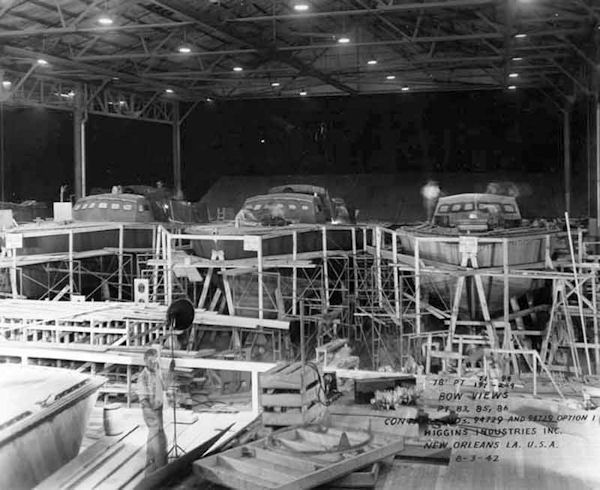
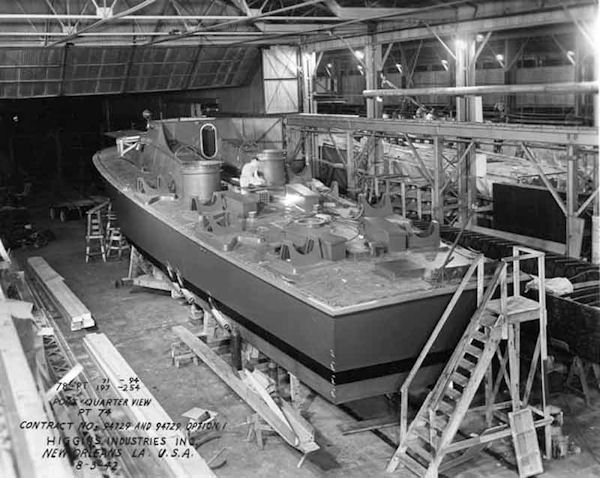
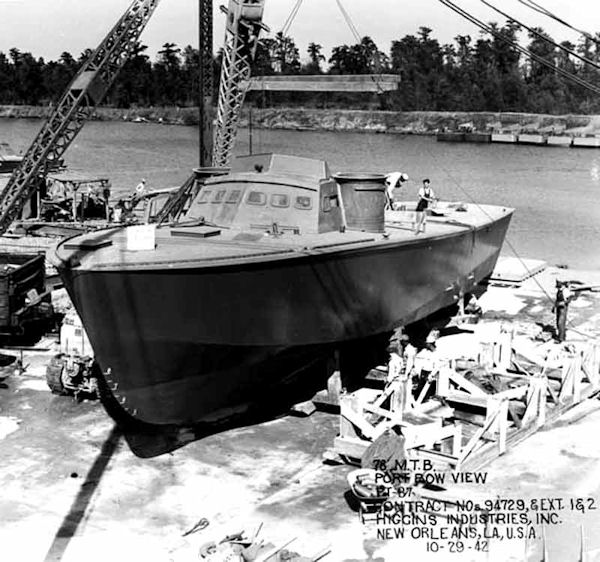
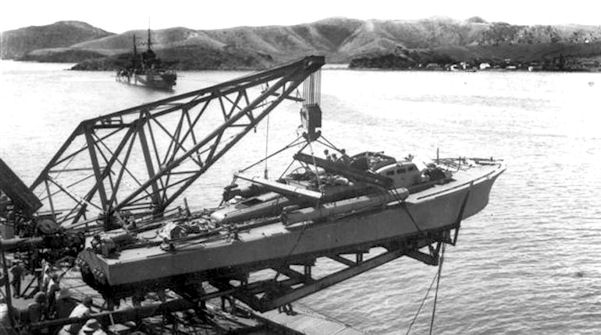
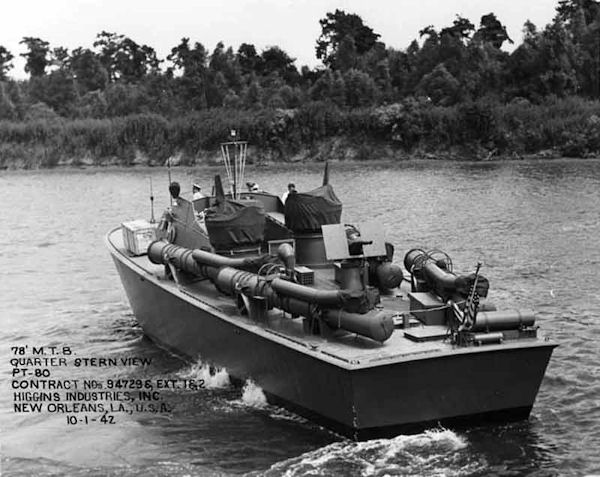
![]()
![]()
![]()